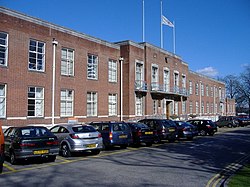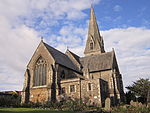Holy Rood Church, Swindon
1851 establishments in England20th-century Roman Catholic church buildings in the United KingdomChurches in SwindonGothic Revival architecture in WiltshireGothic Revival church buildings in England ... and 2 more
Roman Catholic churches completed in 1905Roman Catholic churches in Wiltshire

Holy Rood Church is a Roman Catholic parish church in Swindon, Wiltshire, England. It was founded in 1851 as a chapel and was rebuilt as a church in 1905. It is situated on the corner of Groundwell Road and Lincoln Street in the centre of the town. It was designed by Edward Doran Webb as a Gothic Revival church and was the first Roman Catholic church built in and around the town since the Reformation.
Excerpt from the Wikipedia article Holy Rood Church, Swindon (License: CC BY-SA 3.0, Authors, Images).Holy Rood Church, Swindon
Groundwell Road,
Geographical coordinates (GPS) Address External links Nearby Places Show on map
Geographical coordinates (GPS)
| Latitude | Longitude |
|---|---|
| N 51.558505 ° | E -1.778172 ° |
Address
Holy Rood
Groundwell Road
SN1 2LY , New Town
England, United Kingdom
Open on Google Maps







